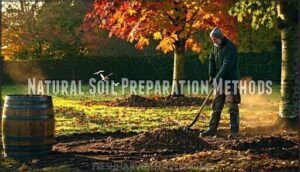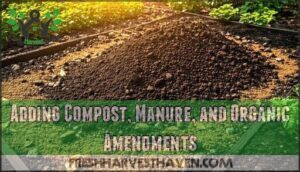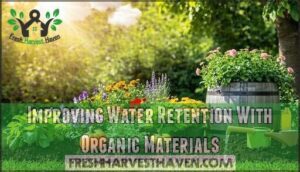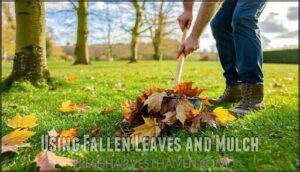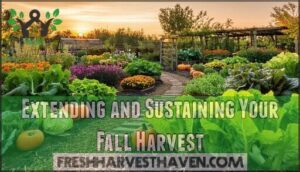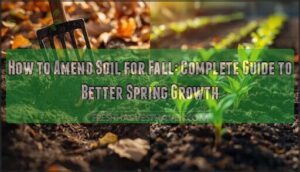This site is supported by our readers. We may earn a commission, at no cost to you, if you purchase through links.
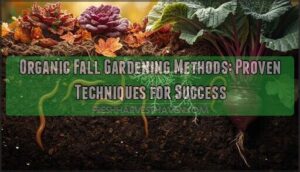
Fall gardens thrive on this biological reset. As temperatures drop and summer’s heat-stressed plants fade, organic fall gardening methods tap into nature’s most productive season for soil rebuilding. Cool nights trigger nitrogen fixation. Decaying organic matter feeds microbial explosions underground.
The harvest you pull from October beds often outperforms July’s yield in nutrient density and flavor. You’ll learn how composting, strategic planting, and natural pest barriers transform autumn into your garden’s most resilient growing window.
Table Of Contents
- Key Takeaways
- Benefits of Organic Fall Gardening
- Preparing Your Garden Organically for Fall
- Choosing and Planting Fall Vegetables
- Organic Pest Control and Disease Prevention
- Extending and Sustaining Your Fall Harvest
- Frequently Asked Questions (FAQs)
- What is organic gardening?
- How do you make a successful organic garden?
- How do you maintain a healthy organic garden?
- How do I Make my organic garden more resilient?
- How does organic gardening work?
- How do you remineralize a garden?
- What is the gardening 3 year rule?
- What is a disadvantage of organic gardening?
- What gardening should be done in the fall?
- What is the easiest crop to grow organically?
- Conclusion
Key Takeaways
- A single composted leaf can boost water retention by 250% and cut chemical runoff by 94%, while organic fall methods leverage cool-season nitrogen fixation and microbial activity to produce nutrient-dense harvests that often surpass summer yields in flavor and nutrition.
- Organic fall gardening sequesters up to 2.31 metric tons of carbon per hectare annually while increasing microbial diversity by 19–21% and beneficial fungi by 287%, creating self-sustaining ecosystems that protect waterways and boost on-site biodiversity by 34%.
- Strategic timing around first frost dates, paired with fast-maturing cool-season crops like radishes (25-40 days) and companion planting for natural pest control, maximizes fall harvests without synthetic inputs or chemical intervention.
- Season-extending tools like cold frames, row covers, and mulching—combined with consistent watering, composting, and native perennial species—transform fall gardens into resilient systems that produce fresh vegetables weeks past first freeze while rebuilding soil for future seasons.
Benefits of Organic Fall Gardening
Fall gardening isn’t just about squeezing in one last harvest—it’s a choice that ripples through your health, your soil, and the world around you. When you grow organically in autumn, you’re working with nature’s rhythm instead of fighting it.
Here’s what that decision brings to your garden and beyond.
Health and Nutritional Advantages
When you grow vegetables organically in fall, you’re not just dodging synthetic chemicals—you’re actually stacking nutritional advantages that can make a real difference at the dinner table. Organic diets deliver crops with stronger nutrient density because healthy soil rich in biodiversity feeds plants the micronutrient levels they need.
Studies show:
- Higher antioxidant benefits in organically grown produce
- Elevated phytochemicals that support immune function
- Reduced pesticides, protecting your body’s natural defenses
That’s sustainable living with tangible payoff.
Environmental Impact and Sustainability
Beyond nutrition, your fall garden becomes a frontline player in environmental conservation. Organic farming practices pull carbon from the air and lock it underground—up to 2.31 metric tons per hectare each year through carbon sequestration. That’s eco-friendly action with muscle.
Your composted leaves increase water-holding capacity by 250%, cutting irrigation needs by a third. You’re safeguarding ecological systems while slashing chemical runoff by 94% compared to conventional methods. Sustainable practices like these protect waterways, boost biodiversity conservation, and counter greenhouse effects—all while building resilience into your landscape. It’s sustainable living that fights pollution and feeds the planet. By adopting soil carbon management techniques, you can markedly improve the environmental benefits of your fall garden.
| Practice | Environmental Benefit | Measurable Impact |
|---|---|---|
| Compost amendment | Water retention improvement | 33% reduced watering frequency |
| Organic mulching | Carbon storage increase | 44% more long-term carbon vs. conventional |
| Chemical-free pest control | Reduced pesticide residue | Up to 94% lower than conventional crops |
| Crop diversity | Biodiversity enhancement | 34% greater on-site biodiversity |
| Natural soil cycling | Lower nitrous oxide emissions | 492 kg CO2 equivalent reduction per hectare/year |
Promoting Soil Health and Biodiversity
Your organic garden practices build living soil—not just dirt. Soil microbes thrive when you skip synthetic inputs, driving nutrient cycling that feeds plants naturally. Compost and mulching strategies boost organic matter, fueling biodiversity conservation and ecosystem services that protect your harvest:
- Microbial diversity jumps 19–21% with organic fertilizer replacing chemicals.
- Soil nitrogen climbs 29% in diverse plantings over two decades.
- Beneficial fungi surge 287% under compost-rich regimes.
- Species richness rises 30% across organic farms, strengthening habitat resilience.
You’re not just growing vegetables—you’re cultivating a self-sustaining ecosystem. By using soil health practices, gardeners can improve the overall fertility and structure of their soil.
USDA Organic Certification Basics
If you’re selling produce or wondering whether your methods could earn that green-and-white seal, here’s what the USDA asks before they’ll call your harvest certified organic.
You’ll need a three-year chemical-free track record, detailed field logs, and a farm inspection by USDA-accredited agents. Once you meet organic standards—no synthetic pesticides, GMOs, or sewage sludge—and pass label requirements, you can display the USDA organic seal on your sustainable agriculture methods and organic produce.
Preparing Your Garden Organically for Fall
Fall preparation starts now, before frost hits and your soil turns unworkable. The methods you choose set the stage for nutrient-dense crops and resilient plants.
Here’s how to build your garden foundation using organic materials and natural amendments.
Natural Soil Preparation Methods
Preparing soil naturally in fall means working with what your land already offers—turning compacted ground into a living system that feeds itself season after season. Start with soil aeration using a broadfork to open pathways without disturbing beneficial organisms.
Layer mulch over beds to protect organic matter through winter. Test pH, then adjust with biodynamic farming inputs like wood ash or sulfur.
Drench beds with compost tea to boost microbial activity before the ground freezes.
Adding Compost, Manure, and Organic Amendments
Your garden doesn’t need store-bought miracles when aged compost, well-rotted manure, and mineral-rich amendments can rebuild fertility from the ground up.
Spread manure fertilizer six inches deep over beds each October. Work in rock dust or greensand as soil amendments for trace minerals.
Top everything with organic mulch to trap nutrients. You’re not feeding plants—you’re feeding soil.
Improving Water Retention With Organic Materials
Fall rains mean nothing if your soil can’t hold what it’s given—organic matter turns sandy beds into moisture-holding sponges and clay clumps into workable ground. Work compost three inches deep to boost soil moisture capacity by forty percent.
Layer organic mulch around plantings for water conservation that cuts irrigation in half.
Feed weekly with compost tea and install rainwater harvesting barrels to fuel your watering techniques without tapping municipal lines.
Using Fallen Leaves and Mulch
Rake those fallen leaves into garden gold instead of stuffing them into plastic bags—every crimson oak leaf and bronze maple drop is free mulch that feeds your soil while locking moisture where roots need it most. Here’s how to turn yard waste into fall garden success:
- Shred leaves with a mower for faster leaf composting and nutrient cycling
- Layer four inches of mulch layers for soil insulation before hard frost
- Mix dry leaves with green compost after fall pruning to balance carbon
Your organic gardening prep starts with what’s already falling around you.
Choosing and Planting Fall Vegetables
Fall’s cooler temperatures open the door to a whole new roster of vegetables that actually thrive when summer’s heat fades. Your success depends on picking the right crops, timing your planting carefully, and setting up smart plant partnerships that work with nature instead of against it.
Here’s what you need to know to fill your beds with productive fall harvests.
Selecting Cool-Season Crops and Varieties
Cool-season crops aren’t just survivors—they’re engineered to flourish when others fail. For your fall garden, choose varieties proven under stress: Belstar and Covina broccoli resist bolting in 90% of plants while delivering reliable side shoots. Kale survives below 14°F with over 80% success.
Swiss chard and spinach maintain production through repeated frosts, supporting organic gardening through crop rotation cycles. Root crops like carrots gain 20% more sweetness post-frost.
Select frost-tolerant varieties matched to your plant hardiness zone, prioritizing seed quality and natural disease resistance for sustainable vegetable garden success.
Timing Planting Around First Frost Dates
Knowing exactly when to plant around your first frost date is the difference between a thriving fall harvest and watching your crops fail before they mature. Use these frost date tracking principles for staggered planting times:
- Check your climate zones and plant hardiness ratings
- Count backward from first frost using crop maturation periods
- Monitor weather forecasting for seasonal scheduling adjustments
- Start early-maturing crops 8-10 weeks before frost
- Use crop rotation to prepare soil while timing fall gardening preparation
This approach protects your investment and maximizes yields.
Fast-Maturing Vegetable Choices
Once you’ve locked in your timing, pick vegetables that can sprint to the finish line—radishes, arugula, and spinach mature in 25 to 40 days, giving you room to work with tight fall windows.
Leafy greens like lettuce and kale thrive as cool season crops, while root vegetables such as turnips and beets reach mature varieties in 45 to 60 days.
Fast growing choices simplify garden bed preparation and deliver reliable harvests when you follow vegetable growing guides for planting vegetables in fall.
Companion Planting for Pest and Soil Health
Pairing your fast-maturing crops with the right neighbors can turn your fall garden into a natural defense system and a soil-building machine. Companion planting boosts beneficial bugs, bolsters soil microbes, and aids pest control without synthetic inputs.
- Garlic or onions near greens repel aphids while building garden diversity
- Radishes with beans break compacted soil and improve crop rotation outcomes
- Calendula or borage attract pollinator plants, supporting organic gardening practices and gardening for biodiversity
Organic Pest Control and Disease Prevention
Fall gardening doesn’t mean surrendering your crops to pests and diseases. You can protect your plants using strategies that work with nature instead of against it.
Here’s how to keep your garden healthy without reaching for synthetic chemicals.
Companion Planting Strategies
Strategic pairing of plants creates a living defense system that turns your garden beds into naturally balanced ecosystems. Crop pairing with plant diversity strengthens biological control—cabbage thrives near dill, while tomatoes guard carrots from pests.
Your garden layout matters: weaving companion planting into rows boosts soil synergy and reduces disease. These sustainable gardening practices and organic gardening methods transform ecofriendly gardening tips into tangible results.
Using Aromatic Herbs for Natural Pest Repellence
Aromatic herbs don’t just season your meals—they emit volatile oils that confuse and repel common fall garden pests without a single spray bottle. Plant basil near brassicas or rosemary along bed edges—these natural insecticides work while attracting beneficial insects.
You’re building herb garden planning into your organic gardening methods, transforming aromatic plant extracts into frontline pest control methods that protect without synthetic organic sprays.
Selective Pruning and Crop Rotation
Cutting away disease-prone stems and shifting crop families to fresh soil each season breaks pest cycles before they spiral out of control. Your pruning techniques clear entry points for fungal spores, while crop rotation—moving tomatoes to where beans grew last year—starves soil-dwelling pathogens and balances nutrient demands.
Together, these garden layout and soil management practices turn crop planning into harvest optimization, keeping your organic fall gardening resilient without synthetic intervention.
Attracting Beneficial Insects
Ladybugs, lacewings, and native bees thrive when you set aside five to ten percent of your garden for beneficial insect habitats.
Plant diverse native flowers—think asters and goldenrod—to boost wild bee abundance by over sixty percent and insect species richness by eleven percent.
Leave dead stems and leaf litter through winter so bees and wasps can nest, cutting pest populations twenty to forty percent without synthetic sprays.
Extending and Sustaining Your Fall Harvest
Your fall garden can keep producing well past the first frost with a few proven protective strategies. The right combination of covers, water management, and soil care lets you harvest fresh vegetables weeks longer than usual.
Here’s how to extend your season and build resilience into your organic garden.
Cold Frames, Row Covers, and Mulching
When frost threatens your tender greens and cool-season crops, a few simple season-extending tools can turn your fall garden into a productive space well past the first freeze. Cold frames trap warmth and shield plants, while row covers deliver frost protection without blocking light. Winter mulching adds soil insulation that stabilizes root zones and locks moisture in place.
Season extension essentials:
- Build or buy cold frames for garden bedding that needs consistent warmth
- Drape lightweight row covers over kale, spinach, and lettuce before nighttime dips
- Layer straw or shredded leaves as mulch around root crops
- Prepare your soil preparation with compost before mulching to boost microbial activity
- Remove mulch briefly on warm days to prevent rot and allow air circulation
These methods protect your fall harvest and set the stage for early spring planting.
Consistent Watering and Rain Garden Construction
Your fall garden won’t thrive on seasonal rain alone—consistent watering keeps roots strong while a rain garden captures runoff and turns drainage challenges into growing opportunities.
Install drip irrigation for steady soil moisture without water waste. Build shallow swales to collect rainwater harvesting and direct it toward your organic beds.
Slope garden drainage toward native plantings that filter runoff while supporting sustainable watering practices throughout the season.
Composting for Ongoing Soil Enrichment
Compost transforms kitchen scraps and garden waste into black gold that feeds your soil season after season—no synthetic inputs required. Boost your soil conditions with these composting methods:
- Layer green waste (nitrogen) with browns (carbon) for carbon sequestration
- Turn piles weekly to activate soil microbes and speed decomposition
- Try vermicomposting indoors during cold snaps
- Brew compost tea to drench beds with beneficial organisms
These soil improvement techniques rebuild soil health naturally.
Planting Native and Perennial Species for Resilience
Perennial garden design and native plant selection anchor your organic gardening methods with species that return year after year, requiring less water and zero pesticides once established. Rooted deeply, these champions excel at soil erosion control and biodiversity enhancement—creating habitat for pollinators while improving soil structure through regenerative gardening.
Integrate permaculture principles by layering perennials with native groundcovers for ecosystem restoration, turning your plot into a self-sustaining model of soil conservation techniques and gardening for biodiversity.
Frequently Asked Questions (FAQs)
What is organic gardening?
Organic gardening is like working with nature instead of fighting it. You skip synthetic pesticides and fertilizers, choosing natural fertilizers and sustainable practices instead.
Plants grow in healthy organic soil enriched through composting and eco-friendly methods that support biodiversity and long-term garden planning.
How do you make a successful organic garden?
You’ll succeed by testing your soil first, then building it up with compost and natural amendments.
Plan for crop diversity, rotate plantings, and keep garden maintenance steady through organic fertilizers and sustainable practices.
How do you maintain a healthy organic garden?
Test your soil regularly and monitor crops closely. Plan ahead, mulch with organic materials, and manage compost for steady nutrients.
These sustainable gardening practices conserve soil and support eco-friendly garden maintenance for organic home gardeners.
How do I Make my organic garden more resilient?
Ironically, the best defense is letting go of control. Build Soil Resilience through diverse plantings and Organic Fertilizers—not sterile monocultures.
The strongest gardens grow from surrender—resilient soil comes from diverse planting and organic methods, not controlled monocultures
Ecosystem Balance and Climate Adaptation emerge when you invite native species, rotate crops, and trust Regenerative Gardening Methods over rigid plans.
How does organic gardening work?
Skip synthetic chemicals and let nature run the show. Natural fertilizers like compost feed your soil with organic matter. Physical pest control and crop rotation replace harsh sprays.
This biodynamic farming approach builds healthy, living soil that sustains your garden season after season.
How do you remineralize a garden?
Rock dust transforms depleted beds overnight. Mineral Balance hinges on Soil Testing first—results guide which Organic Fertilizers or Compost Tea you’ll brew.
Add azomite or greensand to restore Nutrient Cycling, then layer compost to lock everything in place.
What is the gardening 3 year rule?
You rotate crops through different beds every year to prevent disease and pest buildup. The three-year cycle gives soil time to replenish while breaking pathogen life cycles, supporting sustainable gardening and soil conservation without synthetic inputs.
What is a disadvantage of organic gardening?
The biggest drawback? Higher costs and labor-intensive methods mean you’ll invest more time and money.
Limited yields from pest management challenges can frustrate you, especially when garden pests outsmart natural defenses during climate change-driven seasonal constraints.
What gardening should be done in the fall?
Fall garden prep centers on strategic timing. You’ll want to plant cool-season crops like kale and spinach, apply compost for soil temperature management, practice seasonal crop rotation, conduct autumn pruning techniques, and complete garden bed maintenance before frost arrives.
What is the easiest crop to grow organically?
Lettuce, spinach, and radishes top the list for beginner-friendly crops that thrive in garden beds with minimal fuss.
These low-maintenance veggies tolerate varied soil, resist common pests, and offer quick-harvest options from seedlings to plate.
Conclusion
Your soil doesn’t need a smartphone app—it runs on the same microbial networks that fed medieval monasteries and colonial homesteads. By implementing organic fall gardening methods now, you’re tapping into regenerative cycles that outlast any synthetic shortcut.
Cool-season crops will reward your patience with denser nutrition and drought-hardened roots.
Start composting today. Plant your frost-resistant seeds this week. Let decay fuel what grows next, and you’ll harvest proof that nature’s economy never crashes.

